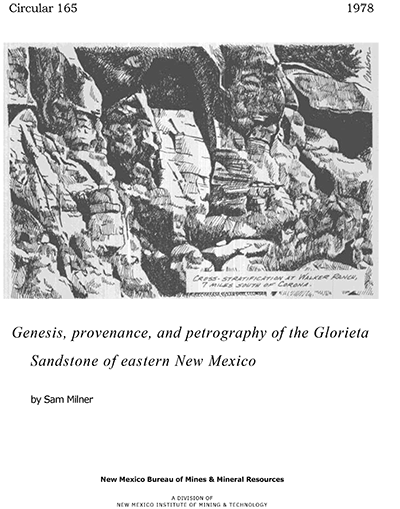
Circular 165—Genesis, provenance, and petrography of the Glorieta Sandstone of Eastern New Mexico
By S. Milner, 1978, 25 pp., 3 tables, 23 figs.

Discusses the upper Yeso and lower San Andres Formations in Lincoln County. Includes the Glorieta Sandstone and Middle Permian stratigraphy outside of Lincoln County. This report is primarily concerned with the genesis, provenance, and petrography of the Glorieta Sandstone Member of the San Andres Formation at its transition into an informal carbonate member in eastern Lincoln County, New Mexico. Hence, the author placed the major emphasis of this study on the upper Yeso and lower San Andres Formations in Lincoln County. However, the Glorieta Sandstone and Middle Permian stratigraphy were also examined outside of Lincoln County to acquire a regional framework within which to better understand the origin of the Glorieta.
The Glorieta Sandstone Member forms the lower 75 m of the San Andres Formation
in northern Lincoln County, New Mexico. Three sandstone tongues, separated
and capped by carbonate tongues, extend southward as the San Andres becomes
predominantly carbonate in southern Lincoln County. The Glorieta Sandstone
is a fine-grained, very well to moderately sorted, calcite-cemented quartz
arenite that is medium to thick bedded. Internal cross-stratification, ripples,
and parallel stratification are common in the Glorieta. The depositional
model for the Glorieta Sandstone is based on the environmental interpretation
of sandstones and associated carbonates and evaporites. Beach-upper-shoreface,
middle-shoreface, lagoonal, and tidal-channel deposits generally typical
of Holocene barrier-island complexes are common. Most of the Glorieta Sandstone
in eastern New Mexico was deposited along north-northeast to south-southwest-trending
coastlines, which were dominated by eastward and southward prograding barrier-island
complexes during relatively low sea levels. Relative low stands were followed
by rises of sea level and the westward and northward transgression and reworking
of regressive deposits. Carbonate deposition was predominant in eastern
Lincoln County following rises of sea level. Glorieta prograding coastlines
were probably localized at the transition between the positive Pedernal
massif and the negative element east of it. The Ancestral Rocky Mountains
and cratonic areas farther to the northeast are probable source areas for
the Glorieta.
$5.75
Buy
Now
Also available as a free download.
Download
| File Name | Size | Last Modified |
|---|---|---|
| Circular-165.pdf | 1.25 MB | 01/11/2021 03:35:20 PM |



